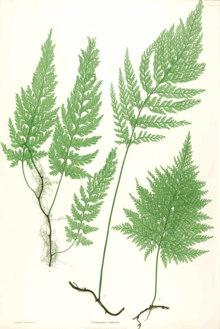Vandenboschia speciosa
| Killarney fern | |
|---|---|
 | |
| Scientific classification | |
| Kingdom: | Plantae |
| Clade: | Tracheophytes |
| Division: | Polypodiophyta |
| Class: | Polypodiopsida |
| Order: | Hymenophyllales |
| Family: | Hymenophyllaceae |
| Genus: | Vandenboschia |
| Species: | V. speciosa |
| Binomial name | |
| Vandenboschia speciosa | |
| Synonyms[2] | |
| |
Vandenboschia speciosa, synonym Trichomanes speciosum,[2] commonly known as the Killarney fern,[3] is a species of fern found widely in Western Europe. It is most abundant in Ireland, Great Britain, Brittany, Galicia, Canary Islands, Madeira and the Azores, but is also found in other locations including France, Spain, Portugal and Italy.[4] It is a relict endemic European species with a disjunct distribution, having had a much wider distribution before the climate changes of the Tertiary and Quaternary periods.[5]
This fern has an unusual life cycle, with a perennial gametophyte phase with an active vegetative reproduction. The gametophyte has the ability to tolerate darker and drier habitats than does the sporophyte.[5] The sporophyte form is found in only 16 locations in the UK although the gametophyte form is more widespread. Once found on Arran, it was thought to be extinct in Scotland due to the activities of Victorian collectors,[6] but the species has been discovered on Skye in its gametophyte form.[7] In the UK it is classed as vulnerable and it is considered one of Europe's most threatened plants.[8] It is found mostly near the western coasts of the United Kingdom and Ireland and at scattered locations inland.[9]
Killarney fern is a medium-sized, long-lived fern with delicate, highly divided, bipinnate fronds arising from a creeping rhizome.[10] It is one of only three European species with translucent leaves and requires a humid, frost-free environment. In Britain, it is largely restricted to damp, shady, sheltered locations such as ravines,[11] although in Ireland it occupies a wider range of habitats. In Brittany, it grows on the stonework of a number of ancient wells.[10]
It became a protected species in the UK in 1975 under the Conservation of Wild Creatures and Wild Plants Act.[12]
References[edit]
- ^ Christenhusz, M., Bento Elias, R., Dyer, R., Ivanenko, Y., Rouhan, G., Rumsey, F. & Väre, H. (2017). "Trichomanes speciosum". IUCN Red List of Threatened Species. 2017: e.T162169A85429885. Retrieved 22 January 2021.
{{cite journal}}: CS1 maint: multiple names: authors list (link) - ^ a b c Hassler, Michael & Schmitt, Bernd (August 2019). "Vandenboschia speciosa". Checklist of Ferns and Lycophytes of the World. 8.10. Retrieved 8 October 2019.
- ^ BSBI List 2007 (xls). Botanical Society of Britain and Ireland. Archived from the original (xls) on 2015-06-26. Retrieved 17 October 2014.
- ^ "Species Action Plan: Killarney Fern (Trichomanes speciosum)" BAP. Retrieved 26 June 2008.
- ^ a b Schuler, Samira Ben-Menni; García-López, María del Carmen; López-Flores, Inmaculada; Nieto-Lugilde, Marta; Suárez-Santiago, Víctor N. (2016). "Genetic diversity and population history of the Killarney fern, Vandenboschia speciosa (Hymenophyllaceae), at its southern distribution limit in continental Europe". Botanical Journal of the Linnean Society. 183 (1): 94–105. doi:10.1111/boj.12492.
- ^ Ratcliffe, Derek (1977) Highland Flora. Inverness. HIDB. page 40.
- ^ "Skye Flora". plant-identification.co.uk. Retrieved 25 May 2008.
- ^ "Species Recovery Programme" English Nature. Retrieved 26 June 2008.
- ^ "Poa nemoralis". Online Atlas of the British and Irish Flora. Retrieved 8 March 2020.
- ^ a b "Killarney fern Trichomanes speciosum". JNCC. Retrieved 8 March 2020.
- ^ "Killarney fern (Trichomanes speciosum)" Arkive. Retrieved 26 June 2008.
- ^ Butler, K. "Conservation of Wild Creatures and Wild Plants Act". Caithness Field Club Bulletin. Retrieved 8 March 2020.


 French
French Deutsch
Deutsch